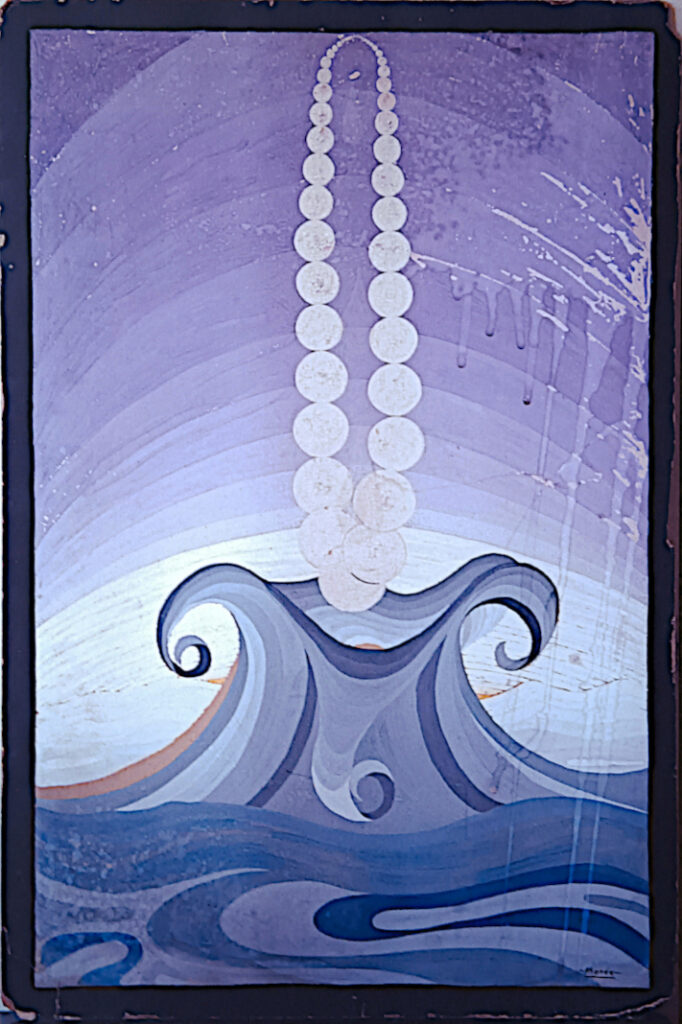Time-Bomb
Morée: A Delayed Time Bomb
The more we examine Morée, the less it resembles a conventional painting and the more it appears to function as a device—an artwork engineered for delayed detonation. Its anonymity, oblique signals, and decades-long absence from any known exhibition or collection all suggest a work designed not for immediate reception,
but for discovery at some uncertain future moment. This strategy aligns with Marcel Duchamp’s most ambitious conceptual maneuvers: treating time itself as an artistic medium, and trusting that an
audience’s perception can be staged and manipulated across decades.

In Morée, the black border recalls the mourning frames and memorial cards of the period, devices meant to acknowledge a death. Within it, the pearls—once emblems of elegance—hang in suspension, about to be swallowed by a cresting wave. The moment freezes just before submersion, as if conventional painting itself were on the brink of disappearance.
Posthumous Planning
Duchamp’s Étant donnés is the most obvious example of such posthumous planning, kept entirely secret for over twenty years and revealed only after his death in 1968.
Morée may suggest a different kind of strategy: one in which the work itself disappears into obscurity, while a second, complementary work—created by another hand—remains visible and identifiable, but its true meaning lost without Morée. Here is where Francis Picabia’s Mistinguett enters the picture.
Duchamp’s strategy of delayed revelation is well-documented in works like Étant donnés. Seen through that lens, Mistinguett might have been positioned to serve as one of the keys that would one day unlock Morée.
The Lock and the Key
If Morée was the lock, Mistinguett may have been the key designed to open it. In isolation, Morée resists attribution: a pseudonymous signature, effaced inscription, and cryptic imagery erase the usual trails.
Conversely, Mistinguett—which appears to borrow and transform Morée’s visual language—does not obviously point back toward Morée. But when Morée does reappear, it invites comparison, and Mistinguett suddenly becomes a decoding tool.
This asymmetry is deliberate. Someone who had seen both might find Mistinguett unlocking the meaning of Morée, but Morée alone offers no clear trail back to Mistinguett. This one-directional relationship ensured that Morée could remain hidden for decades without being “solved” too early. Only once both paintings were known would the circuit be complete, revealing the connection.
A Possible 1915 Window—Recruiting Picabia
These maneuvers weren’t invented in a vacuum. In New York around 1915–17 a small circle of artists refined this vocabulary—deliberate drips, effacements, staged delay. This is where Marcel Duchamp may enter the story.
A useful clue to a possible early 1915 origin comes from a work sold by Alexina (Teeny) Duchamp in 1978. In a June 18, 1979 certification letter, she described a hand-colored photographic study for Nude Descending a Staircase, No. 3 (1916), “executed in 1915”, a time when Duchamp was living with the Arensbergs in New York.
No. 3 was completed in late 1916, and while we can never know Teeny’s reason for the unusual mid-1915 date, it suggests she may have believed Duchamp was already working on something connected to the Nudes during that period at the Arensbergs. If that connection was broader rather than strictly preparatory, then Morée — which may be closely tied in concept to the Nudes — could also have been created in that same window.
In the summer of 1917, Picabia signed and dated Mistinguett, finalizing a canvas whose vertical drips, deliberate surface disruptions, and anti-glamour stance echo Morée’s tactics. The timing suggests he may have had Morée in view, using it as
the basis for a companion piece intended to amplify its coded signals.
The Enigmatic Mistinguett
Yet strikingly, even Picabia’s closest companions had no knowledge of the painting. In a 1962 letter, Gabriele Buffet-Picabia recalled that Francis had known Mistinguett well when the portrait was painted, but she herself—despite her intimate role in his life and her contributions to Blind Man No. 2 in 1917—had apparently never seen the work. Olga Mohler Picabia, who married Francis in 1940, later remembered him speaking several times of a portrait of Mistinguett and wondering what had become of it, but she too had never laid eyes on the canvas. This silence within his inner circle suggests that Mistinguett was deliberately withheld, its secrecy functioning as strategy, not an oversight.
With no documented record until 1952—thirty-five years after its creation—Mistinguett effectively vanished from view for decades. Its long concealment fits the kind of controlled obfuscation that both both artists cultivated: two works, separated in time,
awaiting reassembly.
An Element of Chance
In this sequence, chance isn’t incidental — it’s built into the structure, in a way Duchamp often embraced. For the mechanism to “open,” both paintings needed to survive long enough to exist in the same interpretive space. That activation depended on unpredictable events: survival, reappearance, and the right observer making the connection. In this way, the spectator—and ultimately posterity—would determine when and how the works’ meaning emerged.
A Masterpiece for Posterity
If correct, this reading would position Morée as Duchamp’s most daring experiment in delayed reception. Unlike Étant donnés,
which was preserved intact for planned unveiling, Morée risked complete disappearance. The lock-and-key arrangement with Picabia offered a conceptual safeguard, ensuring that its meaning could remain dormant until posterity itself brought the pieces back together. Seen this way, Morée is less a painting than a device for manipulating time, set to detonate decades later.